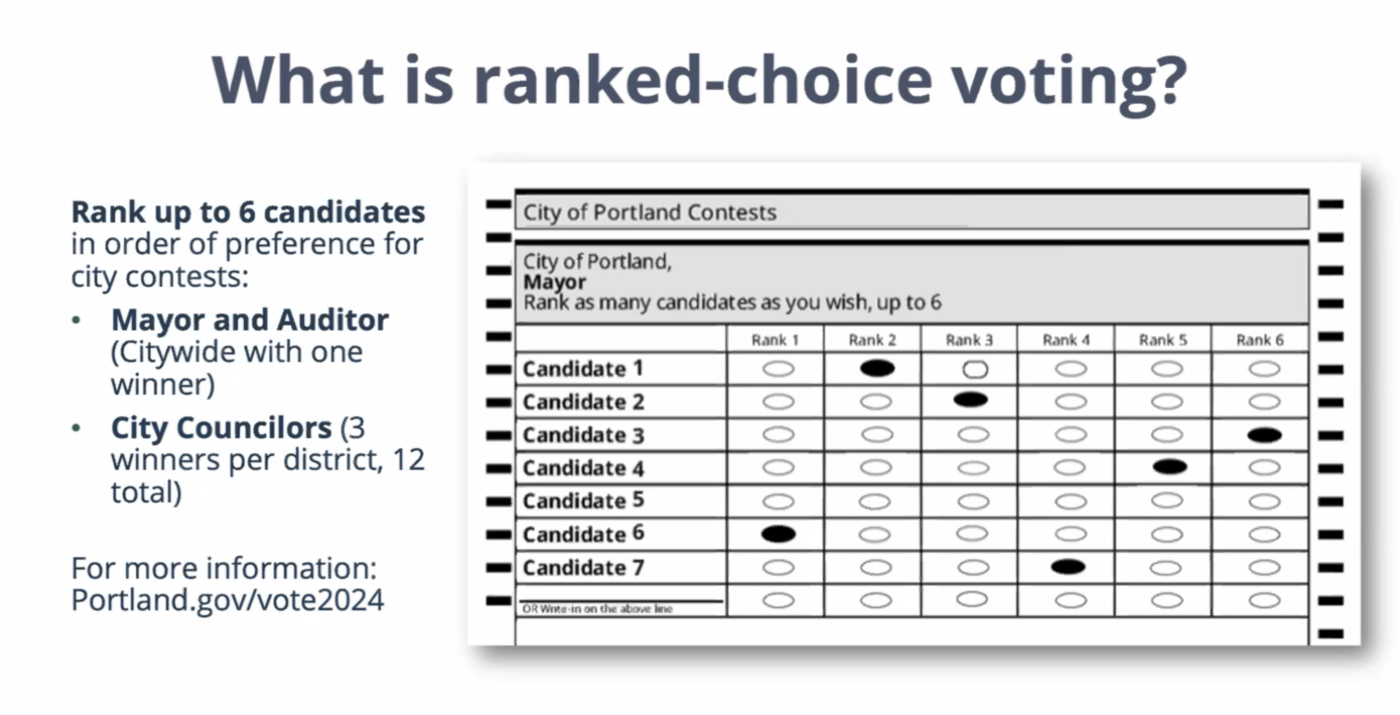
“You all have this!”
Those reassuring words came from Sean Dugar, a panelist at a recent League of Women Voters of Portland community education webinar titled, “Ranked-Choice Voting: Moving Portland Forward with Confidence.”
The League invited four national and local voting experts to share their experiences educating voters about ranked-choice voting (RCV). One of them was Kali Odell, an elections specialist with the Multnomah County Elections Division. I learned a lot from her about how Portland’s November election will unfold. For example, because we vote by mail, and because ballots postmarked as late as election day are accepted, it takes several days for all our ballots to arrive. How does that work with transferring votes and eliminating candidates? Isn’t there a chance that some candidates will be eliminated only to have a bundle of later votes boost their score? How can updated results be posted?
I learned from listening to Odell that the Elections Division will re-run the ranked-choice tabulation afresh, every day, on all ballots received to-date. In other words, they aren’t jiggering new arrivals into an old calculation, rather they recalculate from the start, and each day’s update reflects the rankings from the ballots on-hand.
But I’m getting ahead of myself. What I’m hoping to do by the end of this two-part post is to convince you that Dugar is right, Portland has got this.
Today’s post covers everything up to now — our large field of candidates, single vote transfer, why Portland is using multi-member districts, and the outreach blitz. Later in the week, my second post will get more technical — exhausted ballots, “last one standing” failsafes, and why you should “go for it” with the ranking.
Portland voters are a little skittish
In District 4, at least, I think when our candidate pool surged from a manageable 18, to an overwhelming 30 candidates, people started getting nervous.
And I’ve got to admit, as bullish as I’ve been about RCV, with 30 candidates even I started to imagine scenarios in which the count might get hung up and not return three winning candidates — particularly if voters became dazzled by the sheer number of people running, or if too many voters did not rank enough candidates to arrive at three winners.
So I set out this week to reassure myself and ended up with this post, a Voter Care Package which hopefully has something to reassure everyone.
Where are we: a recap
If you haven’t been paying close attention this past few years, here are two videos which will bring you up to speed about our new voting format in roughly 11 minutes. Even if you are already up-to-speed and know all about RCV in multi-member districts, watch them anyway, they are entertaining, funny and excellent.
The Oregonian explains single transferable vote using doughnuts. As my friend said to me, “I didn’t understand anything until watching this!” (4 minutes, 53 seconds to enlightenment.)
And if you are wondering why it is we need this newfangled system, (4 districts, 3 members each, council of 12; or 4-3-12) Mont Chris Hubbard tells you why in this classic video he made a couple of years ago (using M&Ms).
If you want to know more, maybe from an official source, check out the Multnomah County RCV website. They’ve got practice ballots and other materials. After all that, you will know more than you need to for voting.
But if the sweets are still leaving you hungry, and you are comfortable with statistics, lets go for the meat.
You prefer meat to sweets
The Mathematical Geometry and Gerrymandering Group (MGGG) of Tufts University is a nationally-acclaimed voting research group. They analyzed Portland demographics and modeled several voting and representation schemes to arrive at this 4-3-12 system, and concluded that this method has the best chance of offering the greatest number of Portlanders a voice. It was the MGGG work which informed the Charter Commission’s decision to use ranked-choice voting in multi-member districts (a form of proportional voting).
To better understand what this system means for Portlanders (without having to slog through all the statistics) turn to Kristin Eberhard, writing for The Sightline Institute: Want to Give Portlanders of Color a Voice on City Council? Districts Won’t Help.
Eberhard makes a point about minority representation that is lost on most people writing about our election:
The modeling was about people of color, but the results apply to Portlanders who are in the minority for any number of reasons: small business owners, people who are dependent on transit, those who get around by bike, youth, or parents of school-age children. Most groups don’t all live in just one part of the city, so districts might not help them have a voice, but proportional voting would.
Charter Commission members and advocates who care about better representation on city council—whether for Portlanders of color, or for any other class of under-represented Portlanders—would do well to look to multi-winner races and proportional voting, not single-winner districts.
OK, I get it, but what about everybody else?
Starting now, we are about to be on the receiving end of the biggest outreach blitz we have ever experienced, and that’s saying something in Portland. Voter education is considered part of the RCV implementation process. As I write, in fact, I just received the September newsletter from the City of Portland Transition Team, full of news and seven upcoming events.
And have you noticed the RCV ads that are appearing on BikePortland? Yep, they’re coming for you on your favorite news site (maybe this post even has one). Grace Ramsey, of Democracy Rising, told the LWV audience that,
We want to make sure everyone is coming along, and knows what is going to happen on their ballot. The goal that we have collectively is [that] as few people as possible are surprised on election day to see that ranked choice ballot.
She talked about media, radio, door-knocking, and said they are thinking creatively about “how we can reach people where they are.”
Conclusion
That’s enough for now. You should now know how to fill out your ballot, why we are using proportional RCV, and some of the statistics supporting Portland’s choice of this system. Later this week I’ll do a Part II to this post where I get more technical.







